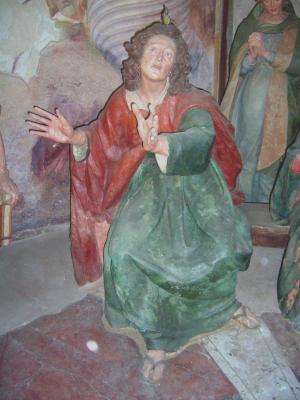Precious art analysed without damage using new laser technique

Precious works of art in need of preservation or authentication could in future be studied using a new laser technique, developed by a collaboration of UK and Italian scientists, that can analyse layers of paint without causing any damage to the object itself. This new technique will be of real benefit to curators of cultural heritage who need to preserve and authenticate precious works of art without harming them.
UK and Italian scientists have, for the first time, tested this laser technique on priceless religious murals and sculptures dating back several centuries. The technique uses laser light to probe through the surface layers to examine the chemical composition of the paint layers beneath. A small number of photons (light 'particles') will scatter back with changed colour, according to the different paint components they represent, allowing the scientists to analyse the chemical composition of artwork in depth.
This new approach, known as 'micro-SORS', is derived from a technique called Spatially Offset Raman Spectroscopy (SORS), which was originally developed by UK researchers at the Science and Technology Facilities Council's (STFC) Central Laser Facility, at the Research Complex at Harwell. Now they have joined forces with researchers from the Institute for the Conservation and Valorization of Cultural Heritage (ICVBC), part of Italy's National Research Council (CNR) to transform the technology for cultural heritage purposes.
Crucially, the technique can identify any areas of decay in the materials beneath the paint, and also pinpoint any earlier conservation work that may have been carried out.

The international team demonstrated last year that the non-invasive micro-SORS method could analyse artificially prepared layers of paint without destroying any part of them. Now they have successfully applied it to real objects of precious art.
The researchers took tiny flakes of paint from murals and sculptures depicting the life of Christ, which are housed in devotional chapels in Northern Italy. Known as Sacred Mounts, these chapels were built several centuries ago and are currently undergoing restoration.
Dr Claudia Conti, a scientist at the ICVBC in Italy, said, "This is a major step forward in developing this new technology for the benefit of Cultural Heritage. I envisage a particularly strong impact on the area of conservation of artwork, where no effective tools for facilitating this analysis presently exist."
Professor Pavel Matousek, from STFC's Central Laser Facility, explained. "The development of micro-SORS combines traditional SORS with microscopy concepts, enabling deeper accessibility than has been possible before. The performance of the prototype exceeded our expectations and promises multiple applications outside of Cultural Heritage, including biology, forensics, polymer sciences and manufacture quality control."
The team hopes to eventually be able to test precious works of art without needing to take samples.
Dr Marco Realini from the ICVBC said, "Micro-SORS promises to make a major contribution to the knowledge and conservation of artworks. We will continue to work with our colleagues at the STFC to take forward this important research. Our ultimate goal is to turn the micro-SORS technology into a portable device that can be also used in the field."
Dr Marco Leona, the David H. Koch Scientist in Charge at the Metropolitan Museum of Art in New York and one of the leading experts in the preservation of cultural heritage, commented, "I had wanted to see SORS being applied in our field for a long time, and the work that Realini and Conti have done with Matousek shows how powerful this technique is. I was frankly surprised to see the quality of the results that can be obtained with a simple and clever adaptation of standard instrumentation. This approach has enormous potential in our field."
More information: "Subsurface analysis of painted sculptures and plasters using micrometre-scale spatially offset Raman spectroscopy (micro-SORS)," J. Raman Spectrosc., DOI: 10.1002/jrs.4673
Provided by Science and Technology Facilities Council




















